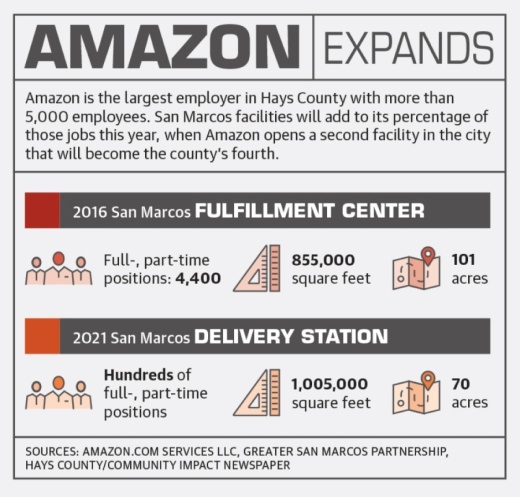The new delivery center, known as SAT6, will be the fourth and largest Amazon operation in the county. The first, an 855,000-square-foot fulfillment center in San Marcos called SAT2, opened in August 2016 with initial employment estimates ranging from 350-1,000. However, those estimates proved conservative.
By the end of 2016, Amazon reported 2,226 employees at SAT2, which increased to 2,935 by the end of 2017, according to economic incentive documents acquired through an open records request.
Employment dipped to roughly 1,850 in 2018 and 2019 for reasons Amazon was unable to share, but surged to 3,119 in 2020 as shoppers avoided stores and went online due to the coronavirus pandemic. Jason Giulietti, Greater San Marcos Partnership president, said SAT2’s workforce has since jumped to more than 4,400.
“It’s just mind-blowing what’s going on there, and what we find is that facility is actually one of their most productive facilities in their global network,” he said. “Productivity levels are just unprecedented there.”
While area business leaders and officials talk up the benefits of having a large-scale employer’s footprint in the county, many facets of Amazon’s local impact remain unclear. The company has pledged to meet an ambitious environmental operations strategy at its coming San Marcos facility, but certain tax and employee numbers, for example, are not legally required to be reported by Amazon.
Without the benefit of complete numbers, financial leaders throughout Hays County are focusing on the positive elements of Amazon’s foothold in the area.
Traci Anderson, executive director of Buda’s Economic Development Corp., said her information was limited, but, like most other business and finance leaders in the area, she sees the good as far outweighing the bad.
All of these facilities are a huge addition to our region,” Anderson said in an email. “With the hundreds of jobs being created in Buda, our workforce has another opportunity to stay in Buda for work.”
A major employer
Giulietti and Jason Mock, the president of the Greater San Marcos Chamber of Commerce, point to the region’s workforce and infrastructure as perhaps the strongest factor when Amazon decided to plant its flags along I-35.
Daniel Martin, operations public relations manager for Amazon, agreed, but also noted other reasons it chooses cities in the capital region and beyond.
“Particularly here in Texas, we look for three things that really need to come together. ... Is there a talented local workforce, is there customer demand, and is there strong support from state and local leaders?” Martin said. “That area kind of checks off all three of those things for us, which is why you’ve seen some of the growth that you have there.”

The number of jobs created for a 305,000-square-foot delivery station in Buda and a 370,840-square-foot sortation center in Kyle, which both opened in 2020, can be difficult to nail down.
Kyle Director of Economic Development Diana Blank-Torres said Amazon’s estimates of its sortation center’s workforce ranged from 200-1,000 before it opened, but the city had not been updated since. According to Amazon, it currently employs more than 200 people in Kyle.
DAU5, the company’s Buda operation, employs some 150 people, Amazon said. When the GSMP announced SAT6, it said Amazon had more than 5,000 employees in Hays County and that there will be hundreds more when SAT6 opens later this year.
Incentives offer transparency, for a price
None of the facilities in Hays County since SAT2 have had an economic incentive agreement, which requires employment reporting for compliance.
Incentive deals can often be a lightning rod for public scrutiny, as Samsung found out earlier this year when it sought a 100% property tax rebate on a proposed $17 billion chipmaking plant in Austin.
SAT2’s incentive agreement included a 40% and 85% rebate on Hays County’s real and personal property taxes, respectively, for 10 years with a possible five-year extension based on the number of jobs maintained from 2023-27. The city of San Marcos provided a matching incentive.
Both local governments also offer a sales tax rebate with a progressive rate based on SAT2’s total sales, but incentive filings show a rebate was not claimed from the county on a total of $207,132 in sales tax revenue for 2017-19 tax years. County filings do not show if a rebate was claimed by the city of San Marcos.
However, compliance certificates show Amazon did request a rebate of $3.2 million on $4.23 million in real and personal property taxes paid to Hays County for the 2017-20 tax years, effectively reducing tax revenue to $1.03 million.
Amazon was eligible for an additional $5.02 million in tax rebates from San Marcos for the same time period, but the company would not confirm or provide additional information about its rebates.
Blank-Torres said although incentives can have a bad reputation, it is better to land a business and get a percentage of some revenue than nothing at all. Job creation and other economic impacts attached to the business also factor into such agreements, she said.
When incentive agreements are not put in place, Blank-Torres said it occasionally has to do with whether the company thinks it is worth its time. Sometimes, she said, opening a facility rapidly outweighs incentives and the time required to form an agreement.
Amazon’s Kyle sortation center was an example of a facility that prioritized a quick build-out. The lease was signed before the building had a certificate of occupancy, and helicopters were used to transport equipment to the building.
Facilities without incentive deals are not required to report employment and tax data but do benefit cities in clear-cut ways by eliminating questions of whether tax breaks are worth the jobs and revenue.
“It is a win-win for everybody,” Mock said. “[Amazon is] able to produce a product and hire great people, and the city and our community is able to receive those tax dollars right away and put them back into the community.”
The broader impact of Amazon’s presence
Amazon’s presence has also benefited the county in recruitment of other businesses, creating more jobs that chip away at the unemployment rate. Blank-Torres noted Lowe’s and FedEx signed leases soon after Amazon leased its sortation center’s property in the Kyle Business Park.
“H-E-B Plus was the catalyst for the retail, and the Ascension Seton Hays Hospital was the catalyst for medical here,” Blank-Torres said of what spurred Kyle’s growth. “Amazon is kind of the first major logistics and distribution company that’s located here.”
Mock and Blank-Torres described Amazon as a sort of testament to a city’s ability to accommodate large businesses.
“At the end of the day, time is money, and any company that’s coming to town wants to know that they can be able to get approval, go through the permitting process and start right away,” Mock said. “Seeing that, what happened with Amazon is that feather in the cap where other developers, other builders and other companies can say, ‘It worked for Amazon; it can work for us.’”
However, the speed and ease of permitting can sometimes become a contentious subject, as it did in San Marcos City Council meetings when approval of a parking variance was leveraged to bargain for environmental sustainability measures at SAT6.
During a Dec. 15 meeting, council members succeeded in adding charging stations for 10 employee electric vehicles and 10 electric semitrailers, a designated rideshare drop-off location and a hydrogen fuel system for vehicles to the site plan. The agreement also required grass-lined channels to help reduce erosion and improve water quality.

A clash over solar panel requirements at SAT6 threatened to delay the facility’s zoning variance and construction during a Jan. 5 council meeting when it became a point of clarification of whether the agreement required panels to be installed or just have the capability of future installation. A 6-1 vote favored the latter.
Martin said Amazon made a sustainability pledge, which commits to powering all of its operations with renewable energy by 2025. The company’s website said it was 42% of the way to its goal in 2019, but Amazon could not provide an update on its progress.
A community partner
Mock said Amazon has programs that help employees with tuition and gives them a path toward a long-term career outside the company. Giulietti also cited the company’s practice of hiring veterans, which he speculated plays into the efficiency of SAT2.
“They just are strong community partners, too, and they really believe in giving back to the community,” Giulietti said. “They come in and actually support different regional programs [and] nonprofit organizations.”
Despite limited transparency, chamber officials and economic development leaders tend to believe the overarching benefits of local Amazon operations are substantial, although no one seems to have the full picture of the company’s impact.
“It’s just kind of an unknown,” Blank-Torres said. “Except for that we do know that it is a positive impact being here.”•





